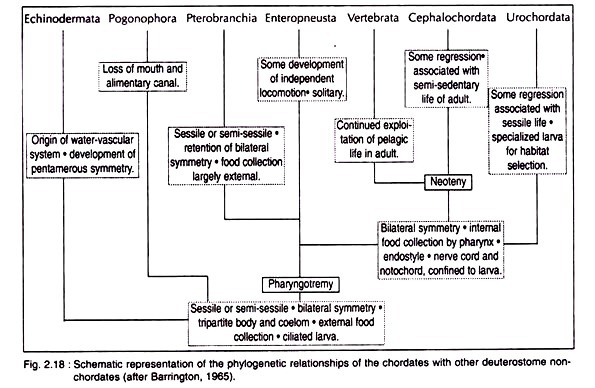Get the answer of: Is Balanoglossus a ‘Forerunner’ of Chordates.
According to any standard dictionary ‘forerunner’ means ‘one who runs ahead’ or ‘messenger sent before’. So the claim that ‘Balanoglossus is a forerunner of chordates’ signifies that it stands at the pivotal stage in the direct line of chordate evolution. But this claim is not universally accepted nowadays. This is because of the peculiar anatomical status of Balanoglossus.
The anatomical peculiarities of Balanoglossus resemble closely those of many non-chordates and, specially, the echinoderms.
It is an well-established fact that many features of Balanoglossus are found both in the non-chordates and chordates.
For instance, we encounter the presence of:
(i) Enterocoelous coelom in all Deuterostomia,
(ii) Radial cleavage in both echinoderms and chordates,
(iii) Creatine phosphate in chordates and some echinoderms. But the three unique chordate characters are not very pronounced in Balanoglossus.
First, the claim that buccal diverticulum represents the notochord has been rejected by Newell (1951) due to (i) lack of its supporting function and (ii) lack of a sheath in buccal diverticulum.
Komai (1951) suggested, that the buccal diverticulum may be homologous to the anterior lobe of hypothesis of vertebrates and the claim of Mukherjee, Ganguly and Gupta (1955) that this structure may be of nervous nature, have also been rejected in subsequent years.
All recent workers believe buccal diverticulum to be a preoral extension of the buccal cavity. The claim that proboscis skeleton might represent the notochord has also been proved to be untrue.
The resemblances between the nervous system of chordates and Balanoglossus are, however, a bit significant. Both are epidermal in nature and Balanoglossus has a dorsal cord, though a ventral cord unlike any other chordate is also present.
At the same time the dorsal nerve cord of Balanoglossus has a lumen at the collar region. The pharyngeal gill-slits, an essential chordate feature are, however, present in Balanoglossus. The pharyngeal gill-slits are the only unquestionable chordate feature.
It is clear that the organisation of Balanoglossus is much lower than that of cephalochordates and urochordates. Rather, non-chordate features outweigh the number of chordate features.
It may be summarised by suggesting that it has:
(i) Many echinoderm-like features,
(ii) Radial cleavage and enterocoelous coelom—common in many chordates and echinoderms,
(iii) Pharyngotremy-like chordates only,
(iv) Partial resemblance between their nervous system and that of chordates,
(v) No notochord,
(vi) Ciliary method of feeding—like other protochordates, though food collection is external in Balanoglossus.
However, it is observed that Balanoglossus excels echinoderms at least in a few points. On this ground Balanoglossus was grouped under a separate Phylum Hemichordata.
But now the question arises whether it should be treated as the direct ‘forerunner’ of chordates or not. On this issue it may be pointed that the initiation of the appearance of some chordate characters may apparently call it a ‘forerunner’ of chordates.
But the absence of notochord, dorsal position of pharyngeal gill-slits, external food collection, lack of distinct dorsal tubular nerve cord and many other features justify that it does not stand on the direct line of chordate evolution. The relationship of these animals showing a degenerative organisation has been shown by Barrington (1965) in recent years.
The claim of Wilder and Hadzi that it is on the direct line of vertebrate evolution is also, therefore, untenable. It may be suggested that Balanoglossus and other chordates are running on the same field, but not in the same track. And out of these two tracks, the track of Balanoglossus has diverged much earlier from the common ancestral main field.
